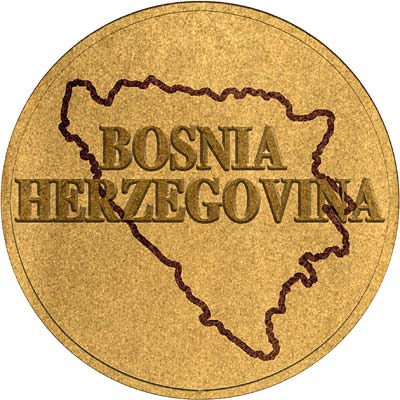| The Very Highest Quality Information... |
| Bosnia-Herzegovina and Bosnian Coins |
|
| ||||||||||||||||||||||||||||||||||||

| ||||||||||||||||||||||||||||||||||||
|
| ||||||||||||||||||||||||||||||||||||
Origins
The name ‘Bosnia’ probably originates from the name of the river Bosna, which was in Roman times known as ‘Bossina’. During the Middle Ages, Bosnia was an independent Christian kingdom, until it was conquered by the Ottoman Empire in 1463.
Herzagovina is a region in the South of the country with no precisely defined borders, but the area was once a Dukedom (Herzog is the German word for ‘Duke’).
Ottoman Rule
Following the annexation of Bosnia, the demographics of the country began to change, and an Islamic Bosniak ethnic group emerged as the dominant demographic group within the province (created largely through bribery of the local population who were offered grain in return for conversion to Islam).
Bosnia became an important source of recruits for the Ottoman Empire, and many natives went on to hold high official rankings within the Ottoman Government, including a former Jannisary who rose to become Grand Vizier (roughly speaking, a kind of Prime Minister) of the Ottoman Empire.
Transfer to Austro-Hungarian Rule
By the 1870s, the Ottoman Empire was in decline. Uprisings during the Great Eastern Crisis saw the liberation of most of the Balkans from Ottoman control. Bosnia and Herzegovina fell under Austro-Hungarian control in 1878. However, nationalism ran high, and nearby independent Serbia opposed Austria-Hungary’s annexation and occupation of Bosnia-Herzegovina.
One of history’s defining moments took place amidst all this, when in 1914, the Bosnian Serb nationalist Gavrilo Princip assassinated the Archduke Franz Ferdinand, Heir to the Austro-Hungarian Throne, along with his wife Sophia.
Austro-Hungarian suspicions that Serbia had been involved in the assassination led to a chain of events which culminated in the outbreak of the First World War. Austria-Hungary was on the losing side of this conflict, and was broken up in 1918.
Kingdom of Yugoslavia
As the various countries of the former Austro-Hungarian Empire went their separate ways, Bosnia-Herzegovina joined with a multi-ethnic union of Slavs to form a kingdom known as the Kingdom of Serbs, Croats and Slovenes, which in 1929 was renamed Yugoslavia.
World War II
As Germany ran rampant across Europe in 1941, Regent Peter signed a Tripartite pact with Germany promising to cooperate with Germany in its desire to invade Greece in order to avoid invasion and takeover. However, this was not popular with the people and a military coup forced Prince Peter from power and King Paul II was declared of age and assumed rule.
Paul II refused to cooperate with Nazi Germany, triggering the invasion and occupation of Yugoslavia, with the government and Royal Family of Yugoslavia driven into exile.
Post War
During the German occupation, both royalists and communists fought with the German occupiers. However, by the end of the war, Tito’s communist partisans emerged as the most powerful faction, and the Royalists were unable to reassume government in Yugoslavia. The country was subsequently renamed the Socialist Federal Republic of Yugoslavia.
Tito governed Yugoslavia until 1980, and upon his death, rivalries between the different ethnic factions began to resurface.
Break Up of Yugoslavia
In 1991, Croatia and Slovenia declared independence. What remained of Yugoslavia was dominated by Serbs. Bosniaks and Croats within Bosnia Herzegovina were not willing to remain in a federation dominated by ethnic Serbs, and began to push for independence. Bosnian Serbs on the other hand, were ferociously opposed to breaking away from Yugoslavia, and when a referendum, which was largely boycotted by the Serbs sanctioned independence, the Bosnian Serb faction went to war in order to separate the Bosnian Serbia from the newly formed Bosnia – Herzegovina state.
A brutal war lasting until 1995 was subsequently fought, with ethnic cleansing and atrocities inflicted on all sides. The most notorious of these was the Srebrenica massacre of July 1995, in which 8,000 Bosniaks, mainly men were massacred by Bosnian Serb paramilitaries.
Under the Dayton Agreement in 1995, which brought the war to an end, the Republika Srpska was recognised as an autonomous Serb Republic within the Bosnia-Herzegovina federation.
Bosnian Coins
The first currency of independent Bosnia-Herzegovina was the Bosnia-Herzegovina Dinar, which replaced the Yugoslav Dinar at par in 1992. No coins were issued for this currency. However, Croatian controlled areas used the Croatian Kuna, and the Bosnian Serbs used their own version of the Dinar.
In 1998, as per the Dayton agreement, Bosnia-Herzegovina introduced a new currency called the konvertibilna marka or 'Convertible Mark'. This was pegged to the Deutschmark at par and retains this peg according to the old Deutschmark's value in Euros.
The Maraka is divided into 100 Fenings. Coins of 5,10, 20 and 50 Fenings are issued, in addition to 1, 2 and 5 Maraka.
For Sale and Wanted
If you are interested in coins from Bosnia-Herzegovina please see our product index:-
Bosnian Coins
Gold Coins
We also have gold coins from Bosnia-Herzegovina on our taxfreegold website:-
Bosnian Gold Coins
| ...at the Lowest Possible Price |
|
32 - 36 Harrowside, Blackpool, Lancashire, FY4 1RJ, England.
Telephone (44) - (0) 1253 - 343081 ; Fax 408058; E-mail: info@chards.co.uk The URL for our main page is: https://24carat.co.uk |
Web Design by Snoop |